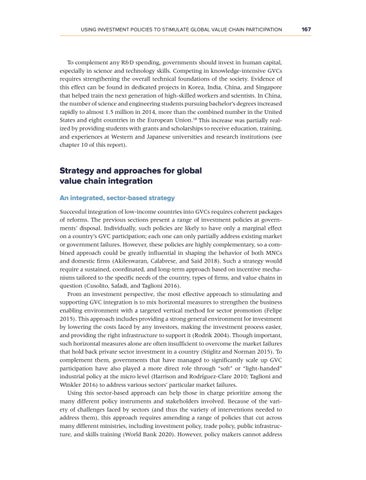Using Investment Policies to Stimulate Global Value Chain Participation
To complement any R&D spending, governments should invest in human capital, especially in science and technology skills. Competing in knowledge-intensive GVCs requires strengthening the overall technical foundations of the society. Evidence of this effect can be found in dedicated projects in Korea, India, China, and Singapore that helped train the next generation of high-skilled workers and scientists. In China, the number of science and engineering students pursuing bachelor’s degrees increased rapidly to almost 1.5 million in 2014, more than the combined number in the United States and eight countries in the European Union.18 This increase was partially realized by providing students with grants and scholarships to receive education, training, and experiences at Western and Japanese universities and research institutions (see chapter 10 of this report).
Strategy and approaches for global value chain integration An integrated, sector-based strategy Successful integration of low-income countries into GVCs requires coherent packages of reforms. The previous sections present a range of investment policies at governments’ disposal. Individually, such policies are likely to have only a marginal effect on a country’s GVC participation; each one can only partially address existing market or government failures. However, these policies are highly complementary, so a combined approach could be greatly influential in shaping the behavior of both MNCs and domestic firms (Akileswaran, Calabrese, and Said 2018). Such a strategy would require a sustained, coordinated, and long-term approach based on incentive mechanisms tailored to the specific needs of the country, types of firms, and value chains in question (Cusolito, Safadi, and Taglioni 2016). From an investment perspective, the most effective approach to stimulating and supporting GVC integration is to mix horizontal measures to strengthen the business enabling environment with a targeted vertical method for sector promotion (Felipe 2015). This approach includes providing a strong general environment for investment by lowering the costs faced by any investors, making the investment process easier, and providing the right infrastructure to support it (Rodrik 2004). Though important, such horizontal measures alone are often insufficient to overcome the market failures that hold back private sector investment in a country (Stiglitz and Norman 2015). To complement them, governments that have managed to significantly scale up GVC participation have also played a more direct role through “soft” or “light-handed” industrial policy at the micro level (Harrison and Rodríguez-Clare 2010; Taglioni and Winkler 2016) to address various sectors’ particular market failures. Using this sector-based approach can help those in charge prioritize among the many different policy instruments and stakeholders involved. Because of the variety of challenges faced by sectors (and thus the variety of interventions needed to address them), this approach requires amending a range of policies that cut across many different ministries, including investment policy, trade policy, public infrastructure, and skills training (World Bank 2020). However, policy makers cannot address
167










